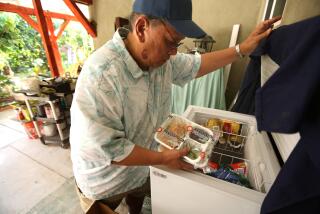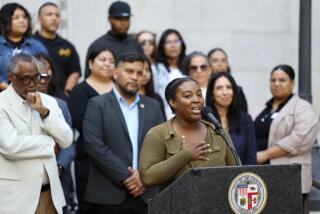Needy, Ailing Are Especially Feeling Pinch : Poor: Free clinics and other social service organizations are swamped. Meanwhile, donations to run the agencies are drying up.
Anyone who thinks the Westside is the exclusive province of rich people who need not fret about a mere recession has only to look through the doors of the Venice Family Clinic to see it isn’t so.
There, in a spacious, modern waiting room just a few miles from some of the wealthiest neighborhoods in the nation, professionals and immigrant laborers sit side by side, waiting patiently for help.
Some wait for hours. Others wait for days just for an appointment, and still others can’t even get that.
And every day, about 70 people are turned away. There just isn’t enough room for them, even at the Westside’s largest community-based free health clinic.
For Fern Seizer, the clinic’s executive director, having to send the needy and the ailing out the door without help has been heartbreaking.
“It’s one of the most difficult things there is,” she said. “There really isn’t any place to send them. We try so desperately to get them in.”
Seizer said the recession has precipitated a 30% increase in patients this year. Every day, more than 130 people are treated for all types of illnesses and given preventive medicine by the clinic’s small group of staff doctors and a corps of volunteers. Of those treated, 92% are below the poverty line, Seizer said, and 94% have no insurance, not even Medi-Cal.
“We are seeing everybody, believe me,” Seizer said. “One teacher, he’s embarrassed about needing free care. He’s afraid his students and their parents are going to find out.”
It’s the same at free medical and psychiatric clinics, homeless shelters, soup lines, domestic-violence counseling groups and other social service agencies throughout the Westside. The need for services is up, and the ability to meet those needs often is not.
Why are so many people coming? It’s simple: Companies are laying off workers and executives to save money, or cutting them back to part time--which generally means eliminating the workers’ medical benefits. Many of these people then become part of the growing number of Westsiders for whom medical insurance is a luxury they cannot afford.
As a result, people are putting off checkups, and coming to the Venice Family Clinic more sick than ever before, according to Dr. Susan Fleischman, the clinic’s medical director.
Some are desperate. Clinic staffers tell of encountering a homeless Ph.D. suffering from exposure, immigrants who have gone years without medical attention, impoverished diabetics in danger of losing an arm or leg.
“There is this perception that the Westside has no poor. That is a problem,” Seizer said during a recent walk through the sprawling Rose Avenue facility, as groups of children squealed and played with toys in the crowded waiting room. “There are very, very many poor people out there. But in government decisions, they average (the entire Westside’s wealth) out, so the area gets fewer resources.”
Catalina Blasi of Mar Vista has been bringing her six children to the clinic for years. Late one recent afternoon, she sat patiently as her allergy-prone teen-age son, Martin, wheezed and snoozed on her lap, waiting for his weekly shot.
“Before, they would take you right away,” said Blasi, who said she had been waiting more than an hour. “Now, it takes two or three days. There are so many people coming.”
Jennifer Sangis, 21, waiting with a friend, recalled a visit to the clinic about eight months ago when she was new to town, and sick. She said she had made an appointment five days earlier, and still had to wait six hours.
“There were tons of people,” Sangis said, “and no place to sit.”
Most social service providers have to grapple with overflow crowds at one time or another. But they say the recession has made their task nearly overwhelming.
At several agencies, officials mentioned the term “double whammy” in connection with the recession: The soured economy not only generates a greater demand for services, it also leads to a decline in the private and corporate donations the agencies depend on.
Officials at the Family Clinic are nervous, saying that people are still giving, but that the clinic is depending on its annual Venice Art Walk fund-raiser in early June to net $600,000 to cover increased costs.
“It’s scary how critical this one day is,” Seizer’s assistant, Ellen Robinson, said of the Art Walk. The clinic depends on private support for three-fourths of this year’s $3.2-million operating budget, and Robinson said she was worried that patrons won’t be buying as much art this time around.
There are similar concerns at the Los Angeles Free Clinic, the Westside’s other major community-based medical clinic.
More and more unemployed and uninsured people are showing up, according to clinic Executive Director Gary Bess. Meanwhile, the clinic’s fund-raising efforts are down by at least $40,000, and it is expecting a reduction in funds from United Way this year.
United Way itself fell $12 million short of its fund-raising goal this year, and scores of Westside nonprofit agencies will feel ripple effects in the form of a 17% cut in their United Way funding.
For many agencies, the reduction will be very painful.
At Family Service of Los Angeles, the recession has generated a surge in demand for counseling, said President Tony Lufrano. Nonetheless, the agency may have to cut services at its 12 centers, including a Mid-Wilshire facility at which two clinical social workers are carrying a heavy caseload.
“People are in jeopardy of losing their homes since they’ve lost their jobs,” Lufrano said. “They’re stressed over how they are going to cope, survive, and even over basic things like how to feed their children and keep them housed.”
On Western Avenue near the eastern edge of Hollywood, the 101 beds at the United States Mission homeless shelter are always filled.
Office Manager John Nelson laments that fund-raising is down 20% because of the recession. But the need is great, so there is no choice but to push on.
“It’s getting hard,” he said. “But we’ll just have to struggle along.”
Public Assistance
The recession has brought a sharp increase in the number of people seeking aid from the three big public assistance programs for the poor--Aid to Families with Dependent Children, General Relief and Food Stamps--in four Westside cities. (Separate data for the Westside portions of Los Angeles was not available.)
AFDC General Relief Food Stamps City ’89 ’90 ’89 ’90 ’89 ’90 Beverly Hills 121 210 24 24 18 38 Culver City 675 999 69 117 103 107 Santa Monica 1,088 1,693 246 358 354 416 W. Hollywood 534 996 185 312 86 149 WESTSIDE 2,418 3,898 524 811 561 710 COUNTY 555,341 638,987 48,898 56,378 78,707 91,520
Figures are estimates from September of 1989 and December of 1990
Source: Los Angeles County Department of Public Social Services
More to Read
Sign up for Essential California
The most important California stories and recommendations in your inbox every morning.
You may occasionally receive promotional content from the Los Angeles Times.










